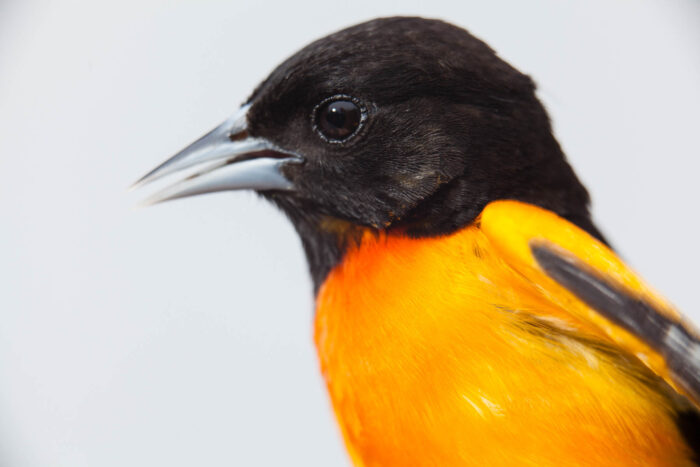Baltimore Oriole
Icterus galbula
Baltimore orioles are orange and black songbirds, slightly smaller than a robin. They visit the Chesapeake Bay region during the summer months.
This section shows one large critter image at a time. Use the thumbnails that follow to select a specific image to display here.

This gallery contains a grid of small thumbnails. Selecting a thumbnail will change the main image in the preceding section.
Appearance
Baltimore orioles are between 6.5 and eight inches in length and weigh one to 1.5 ounces, making them slightly smaller than a robin. They have a wingspan of 3.5 to four inches. Males are brighter and slightly larger than females. Males are black with bright orange on the breast, tail and wing bars, while females are an olive-brown to yellow color with white wing bars and a gray bill. Young birds will have the paler female coloring until they are a year old.
Feeding
Baltimore orioles primarily eat insects and fruit. They will catch insects by searching through foliage or even in midair. Orioles eat many pest insects, including the forest tent caterpillar. In suburban areas, orioles can be drawn to fruit or jelly in feeders. They may also feed on nectar from flowers.
Predators
Orioles have a variety of predators, from larger birds, like crows and screech owls, to mammals, like squirrels and domestic cats. Their predators typically target eggs or nestlings. Orioles have distinct alarm calls to warn of predators, and will mob and harass predators that come near.
Flight
Orioles in flight can be identified by their bright orange underside. They tend to fly in direct paths, unless using wing movements to communicate.
Voice
Male orioles sound flute-like, and each one has a different song. Female songs are shorter and less complex than the male versions. Both whistle a “hew-li” sound, which is distinct from any other birds in its range. Nestlings are also quite loud, especially when they’re hungry.
Reproduction and life cycle
Orioles breed once yearly between May and June. Males try to attract females by bowing, singing and displaying their plumage. Females may respond with songs or a display of quivering wings, or may ignore the males. Nests, which are woven pouches that hang from tree branches, are built almost entirely by the female. She will usually lay four pale-gray to bluish-white splotchy eggs. The eggs incubate for two weeks before hatching. For the first two weeks of life, the fledglings stay in the nest and are fed by their parents. After that time, they become independent. Baltimore orioles have a lifespan of up to 11.5 years in the wild and up to 14 years in captivity.
Did you know?
- Females become a deeper orange each time they molt. Older female orioles can be almost as bright as the males.
- Baltimore orioles got their name because of the black and orange of Lord Baltimore’s family crest, which matches their plumage.
- Orioles prefer dark, ripe fruit like mulberries, cherries and purple grapes and will ignore lighter fruit like green grapes.
- Baltimore orioles are important for pest control, as they feed on caterpillars that can do serious damage to forests.
- The scientific name “Icterus” comes from an Ancient Greek word for yellow bird, while “galbula” comes from a Latin name for a yellow bird.
- The Baltimore oriole is Maryland’s state bird.
Sources and additional information
- Icterus galbula – Animal Diversity Web, University of Michigan Museum of Zoology
- Baltimore Oriole – All About Birds, The Cornell Lab of Ornithology
- Baltimore Oriole – Guide to North American Birds, Audubon Society
